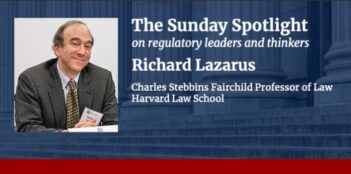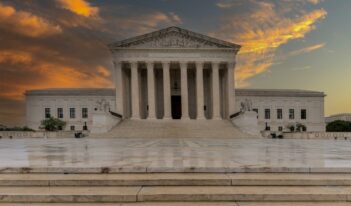
The Supreme Court’s 2014-15 regulatory decisions affected environmental law, employment discrimination, and public safety.
In today’s political climate, regulatory agencies often take center stage in ideological warfare between factions holding starkly divergent views about federal power. These governance battles are waged not merely in the agencies themselves, but also in the Congress and in the courts. And many times, the skirmishes that start in lower courts around the country ultimately find their way to the Supreme Court in Washington.
This past term, the Supreme Court decided a considerable number of important regulatory cases. The Regulatory Review has already reviewed a number of those cases, including those involving the question of whether a fish can be regulated under the Sarbanes-Oxley Act and of when state boards can be subject to federal antitrust laws. But the Court also reached decisions on environmental policy, whistleblower protections, and the extent to which the courts can review certain administrative actions.
The reviewability of administrative action arose in a case involving the federal government’s role in regulating employment to protecting employees’ rights to be free from discrimination by employer. But in Mach Mining, LLC v. Equal Employment Opportunity Commission, the Court reaffirmed that employers have rights too.
Title VII of the Civil Rights Act of 1964 requires that before the Equal Employment Opportunity Commission (EEOC) can sue an employer for alleged employment discrimination, it must first attempt to remedy the purported violation through informal means. In this case, the EEOC sent two letters to Mach Mining about allegations of sex discrimination. The first letter included a statement that a representative would be contacting Mach Mining about informal conciliation proceedings; a year later, the EEOC dispatched a second letter indicating conciliation had failed and that it would be filing suit against the employer.
Federal law also dictates that what occurs during a conciliation process may not be used as evidence in a subsequent proceeding. When the EEOC filed suit, Mach countered that the EEOC failed to meet its statutory burden for conciliation – as there was no record of whether the conciliation process had occurred. But the EEOC moved for summary judgment, arguing that conciliation is not subject to judicial review.
The Supreme Court unanimously disagreed, holding that the EEOC must show that it disclosed the substance of the charge to the employer and engaged the employer in an effort to resolve the alleged discriminatory behavior. In the face of concrete evidence that the EEOC failed to meet this requirement, the Supreme Court said that a trial court is permitted to proceed with fact-finding in order to determine whether the EEOC has complied with the law.
At issue in Department of Homeland Security v. MacLean was whether a federal air marshal turned whistleblower can receive protection from a statute intended to shield government employees who reveal “a substantial and specific danger to public health or safety” from negative consequences.
The case arose after air marshal Robert J. MacLean learned that the Transportation Security Administration (TSA), a division of the U.S. Department of Homeland Security, had canceled certain overnight missions. Having just been briefed on a specific terror threat, MacLean believed the TSA was jeopardizing public safety to save money, so he contacted the press and disclosed the cancellations. When the TSA found out, MacLean was fired.
MacLean claimed that his disclosure was protected whistleblowing, but the TSA argued that whistleblower protections do not apply individuals who violate the law in the course of making disclosures. According to the TSA, agency regulations specifically ban disclosures of the type MacLean made. But the Supreme Court held to the contrary, in a 7-2 decision, concluding that the TSA’s internal regulations do not constitute “law” for the purposes of the whistleblower statute. As a consequence, the Court said MacLean should be entitled to whistleblower protections.
One of the most significant regulatory issues before the Supreme Court this term involves the U.S. Environmental Protection Agency (EPA). In Michigan v. Environmental Protection Agency, industry groups and twenty-three states challenged the EPA’s 2012 Mercury and Air Toxics rule promulgated under the Clean Air Act (CAA). The Petitioners claimed the agency improperly refused to consider compliance costs when it issued rules regulating hazardous air pollutants emitted by coal- and oil-fired power plants.
The CAA requires that the EPA may only regulate power plants if it first determines that a regulation is “appropriate and necessary.” The EPA argued that the rule was appropriate because of the significant public health concerns associated with certain air toxins and necessary because existing rules were insufficient to meet those concerns. In a narrow 5-4 vote, the Supreme Court disagreed. The Court held that the EPA did not meet the “appropriate a necessary” burden when it determined that costs were irrelevant to the rule. The agency estimated the costs to be $9.6 billion annually with resulting benefits between $4 and $6 million per year.
The Court’s decision does not doom the prospect of regulating toxic air emissions from power plants under the CAA, but the EPA will have to return to the drawing board to determine a method for calculating and considering costs as part of its “necessary and appropriate” analysis.
This essay is part three of a five part series, The Supreme Court’s Regulatory Term.



